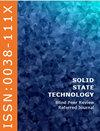Dssc Performance of Zinc - Tin - Vanadium Oxide Nanocomposite Using Beetroot (Beta Vulgaris) as Dye Sensitizer
Q4 Materials Science
引用次数: 1
Abstract
In this present work, zinc - tin - vanadium oxide (ZTVO) nanocomposite was prepared using hydrothermal route and was subjected to calcination at 600 0 C. The sample was systematically characterized by Powder X-ray Diffractometer (XRD), Attenuated Total Reflectance (ATR), Field Emission Scanning electron Microscope (FE-SEM), Transmission Electron Microscope (TEM) and Ultraviolet- Diffuse Reflectance Spectroscopic techniques. From the investigations, it is observed that this composite possess the combination of both individual and binary phases. The elongated nanostructures obtained due to the binary phases and spherical shaped nanostructures obtained due to the individual phase were observed from the FE-SEM image. The formation of the nanocomposite has further been confirmed from TEM and HRTEM images. ZTVO nanocomposite possess large surface area of 167.3 m2/g and pore size value around 11 nm. Also, the band gap of the material has been found to be 1.97 eV. Dye-sensitized solar cell (DSSC) has been fabricated using this ZTVO nanocomposite as the photoanode and betalain dye extracted from beetroot (Beta vulgaris) as the natural dye. This simple protocol was formulated at a low cost for the first time for DSSC fabrication and it has attained the efficiency of 3.41%. This better efficiency of ZTVO might be due to larger surface area, presence of pores in addition to smaller band gap.甜菜根(Beta Vulgaris)染料敏化剂对锌-锡-氧化钒纳米复合材料Dssc性能的影响
本工作采用水热法制备了锌-锡-钒氧化物(ZTVO)纳米复合材料,并在600℃下煅烧。通过粉末X射线衍射仪(XRD)、衰减全反射仪(ATR)、场发射扫描电子显微镜(FE-SEM)对样品进行了系统表征,透射电子显微镜(TEM)和紫外漫反射光谱技术。从研究中可以观察到,这种复合物同时具有单个相和二元相的组合。从FE-SEM图像中观察到由二元相获得的细长纳米结构和由单个相获得的球形纳米结构。TEM和HRTEM图像进一步证实了纳米复合材料的形成。ZTVO纳米复合材料具有167.3m2/g的大表面积和11nm左右的孔径值。此外,已发现该材料的带隙为1.97eV。使用这种ZTVO纳米复合材料作为光阳极,并使用从甜菜根(Beta vulgaris)中提取的甜菜碱染料作为天然染料,制备了染料敏化太阳能电池(DSSC)。这种简单的方案首次以低成本制定用于DSSC制造,其效率达到3.41%。ZTVO的这种更好的效率可能是由于更大的表面积、除了更小的带隙之外还存在孔隙。
本文章由计算机程序翻译,如有差异,请以英文原文为准。
求助全文
约1分钟内获得全文
求助全文
来源期刊

Solid State Technology
工程技术-工程:电子与电气
CiteScore
0.30
自引率
0.00%
发文量
0
审稿时长
>12 weeks
期刊介绍:
Information not localized
 求助内容:
求助内容: 应助结果提醒方式:
应助结果提醒方式:


